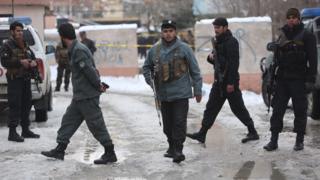 At least 20 people have been killed in a suicide bombing at Afghanistan’s Supreme Court in Kabul, officials say.
At least 20 people have been killed in a suicide bombing at Afghanistan’s Supreme Court in Kabul, officials say.
Another 45 people were injured. The number of casualties is expected to rise.
The bomber targeted the car park of the court compound, reports say. The injured are being ferried to hospitals.
There was no immediate claim for the attack, which follows a number of deadly bombings by the Taliban and other militants in recent months.
The attack came hours after a senior district official in western Farah province was killed in a bombing claimed by the Taliban.
The suicide bomber in Kabul appeared to be targeting court employees as they left the court to go home, officials said.
He was on foot and detonated a suicide vest, said Najib Danish, a spokesman for the interior ministry.
« My father and I were exiting through the parking lot when a huge blast hit us, » a witness told the AFP news agency. « My father is dead now. How will I live without him? »
The force of the explosion is said to have shaken nearby buildings, breaking windows and sending debris flying into the streets.
President Ashraf Ghani called the bombing a « crime against humanity and an unforgiveable act ».
In the past, Afghan judicial institutions, including the Supreme Court in Kabul, have been targeted by Taliban militants.
Last month twin bombings near the parliament in Kabul that were claimed by the Taliban killed more than 30 people and wounded many more.
The blasts took place during rush hour as staff were leaving the parliament complex.
The latest attack highlights the worsening security situation in Afghanistan. The UN said on Monday that civilian casualties in the country have hit a new high , with 3,498 civilians killed in 2016.
The death toll marked a 3% rise on 2015, but included a ten-fold increase in casualties from attacks linked to militants from the so-called Islamic State (IS).
IS has carried out many recent attacks in Kabul, though the militant group has mostly targeted the country’s Shia community.
The Afghan government controls no more than two-thirds of the country.
Most Nato troops left at the end of 2014 but some 13,000 foreign troops, more than half of them American, remain in training and advisory roles.






